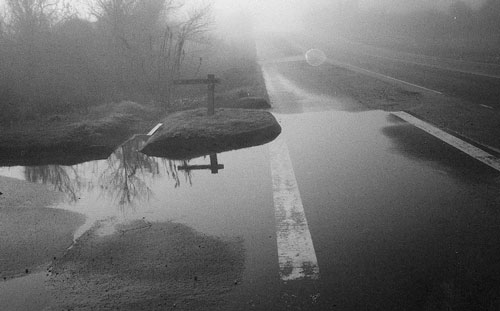There are many drainage features on and along streets and highways. They include the curbs and gutters, drop inlets and catch basins, pipes, culverts, and ditches needed to collect and carry storm drainage away from the road. When these features are located on a roadway or are adjacent to it where a vehicle, bicycle or pedestrian has a chance of traveling over or into the feature, the drainage feature should be designed for safety.
Drainage features that have been designed for safety, crash tested, and found to operate safely under the design conditions are usually referred to as crashworthy. Basically, crashworthy means a highway feature or appurtenance will not stop a vehicle abruptly, cause the driver to lose control or cause the vehicle to roll over.
This section describes corrective measures that can be taken to mitigate the effects of an identified drainage problem that affects safety.
Correcting the Effects of Erosion on Roadway Side Slopes
Side slopes, both cut and fill embankments, and ditch sides, are usually constructed in the ranges of 1V:3H to lV:6H (or 1V:8H in relatively flat areas). Steeper slopes pose greater safety risk to motor vehicles traveling across or down them. These steeper slopes are also more difficult to maintain.
Side slopes of 1V:4H or flatter are commonly accepted as safe side slopes. These slopes are traversable and recoverable. Drivers of errant vehicles can steer, brake, and recover from a run-off-the-road mistake.
Side slopes between 1V:3H and 1V:4H offer marginal safety for vehicles. These slopes are called traversable, but non-recoverable and vehicles will travel beyond the bottom of the slope; therefore, a recovery area should be provided at the bottom of the embankment.
All slope surfaces should be smooth, free of fixed objects, and free of snagging features, such as headwalls. Vehicles traveling down slopes are difficult to control and may strike, roll over or drop into a feature such as a pipe end, which can cause a vehicle to halt abruptly, become unstable and roll over, or strike the back of the slope.
Erosion scars on a side slope can also initiate vehicle instability by tripping the vehicle’s wheels and initiating overturning. Therefore, eroded slopes should be graded and seeded. When rip rap is used to control and spread the flow of water, it should have shallow inverts and be placed flush with the existing ground. Additionally, the roadside conditions should be checked to determine why erosion is taking place and the problems resolved.
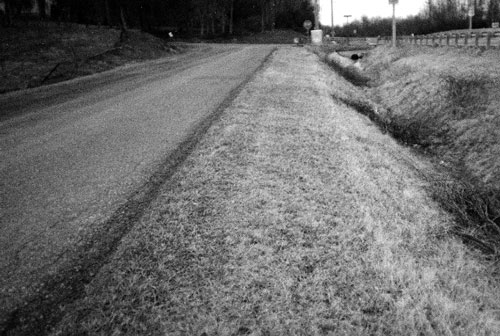
Correcting the Effects of Erosion on Roadway Hardware
Soil erosion can have a detrimental effect on safety appurtenances, such as guardrail, sign supports, and highway light supports. The deposit of several inches of eroded soil or the erosion of several inches can significantly reduce crashworthy characteristics.
Soil deposited around breakaway appurtenances can cause them to malfunction or simply not break away. Additionally, run-off can result in the erosion of soil around these safety features, reducing their operational characteristics, such as deflection on impact rather than breaking away. This can cause a vehicle to roll over or abruptly stop.
Eroded and silted areas around barrier posts, breakaway sign supports and highway light supports should be restored to the desirable ground level and seeded. If the area continues to erode, bituminous overlays may be considered.
Desirably, drainage channels should not end near a safety feature or drain adjacent to one where soil can erode around it.
Correcting the Effects of Erosion on Culvert and Pipe Ends
Pipes and culverts may have headwalls or special pipe end sections. Headwalls tend to channel water around their edges and can cause erosion gullies to develop. The storm flow from the pipe or culvert can also erode the sides of a paved channel or the bottom of a graded channel. If these water channels erode, they can create gullies on the side slopes that can trip the wheels of an errant vehicle or bicycle causing instability, loss of control or initiating a vehicle rollover.
Pipe and culvert ends should be checked annually or after major storms. Debris that can divert water flow should be removed and eroded areas reestablished with soil/aggregate mixtures and reseeded. Additional measurers may need to be taken to reduce erosion, such as paving the channel in areas where erosion continues.
Correcting the Effects of Erosion on Ditches
Roadside ditches and channels are often cut into the roadside immediately adjacent to the roadway. There are designs for ditches that ensure their traversability, meaning a vehicle or bicycle can pass over the ditch or channel at the travel way speed without abruptly stopping, losing control or being rolled over. Recommendations for ditch cross sections (front slope, bottom, depth, and back slope) can be found in the current edition of the Roadside Design Guide. The choice of a traversable ditch section depends on the amount of run-off, the grade of the roadway, slope and soil conditions and speed of vehicles on the highway.
Both earth and lined ditches require maintenance to remove debris and prevent erosion that can create roadside hazards and/or reducing the effectiveness of the drainage system. It is important when repairing eroded earth ditches and shoulders to restore them to their original safety shapes. Ditch side slopes that are too steep and ditches that are too deep can initiate instability in a vehicle causing it to roll over or cause the vehicle to snag against the ditch back slope and abruptly stop or vault the vehicle into the air.
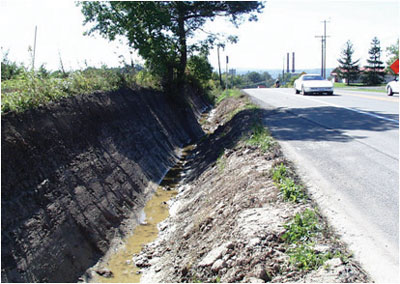
Earth roadside ditches that continue to erode and require regrading one or more times a year should be considered candidates for paving or some other form of lining that eliminates erosion and reduces the speed of the run-off. Rock and stone ditch linings should be smooth and not “bumpy” so the driver can retain control of the vehicle.
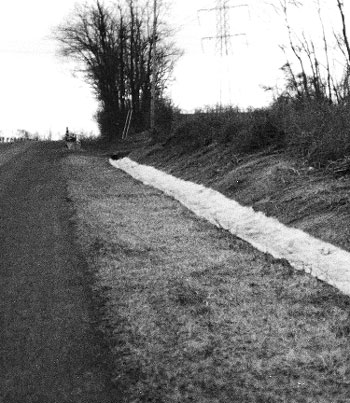

Roadside ditches, along with the other drainage features such as drop inlets, should be checked annually and after major storms to ensure they are not clogged with debris or eroded.
Roadside ditches that are not traversable by design, as a result of previous maintenance actions or because of erosion, should be redesigned to be consistent with those recommended in the current edition of the Roadside Design Guide (see discussion under section 3.2.4 Roadside Channels for preferred cross section).

Maintaining and Improving the Safety Characteristics of Inlets
Drop inlets and catch basins in and adjacent to roadways are one of the most common drainage features especially in urban and suburban areas where curb and gutter design is used. Inlets are designed to carry surface run-off from the road and roadside away from the roadway. Inlets can be of varying design, including curb openings, grates, or a combination of these. Many local agencies use a standard design for most of their drop inlets on and adjacent to low-speed, low-volume roads. Inlets on higher level highways are often specially designed or selected to meet the conditions of greater but less frequent storms.
Drop inlets located in or adjacent to the path of motor vehicles, pedestrians and bicycles require grates that can accommodate run-off while preventing vehicles, bicycles and pedestrians from falling into the inlet. When bicycle traffic exists, grates should prevent the tires of a bicycle from slipping into and being caught in the grate. Therefore, bicycle safe grates should be used whenever bicycle traffic is expected. The photo below shows a preferred treatment for a drop inlet located on or near a bicycle travel way. With a flush bicycle-safe grate, a bicycle tire cannot get caught in the grate because of the cross pattern of supports which results in only small openings.
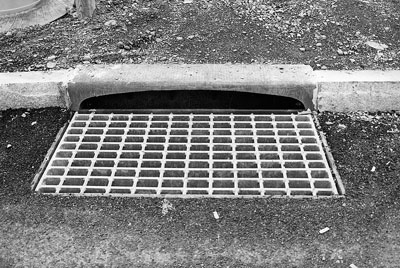
Drop inlets should not be in the path of pedestrians. To avoid run-off across a pedestrian crosswalk it is desirable to locate the catch basin and inlet before the crosswalk as depicted on next page.

Raised roadside drop inlets, sometimes referred to as table top inlets, provide a vertical opening in their sides for large volumes of run-off and debris removal. They are usually located in low-depressed or sump areas.
Raised inlets located in areas where an errant vehicle or bicycle can drive into or over them should be no higher than 4 inches above the surrounding ground. Drop inlets that extend more than 4 inches above the surrounding ground can snag the undercarriage of a vehicle in the same way a raised headwall can, causing it to abruptly stop, go out of control, or roll over. A safer drainage treatment is to use a grated inlet that is close to the ground as shown below.

Eliminating or Improving Hazardous Drainage Headwalls
Headwalls are common features on many local roadways. The headwalls are often used to support the shoulder and maintain the roadway edge, prevent the end of the pipe from being crushed or broken when overridden, collect and disperse water flows and occasionally delineate the ditch or channel. Headwalls, by their nature, are generally rigid structures capable of abruptly stopping a motor vehicle if hit. When they are located on side slopes they may be potential hazards, causing loss of control, ramping or vehicle roll over.

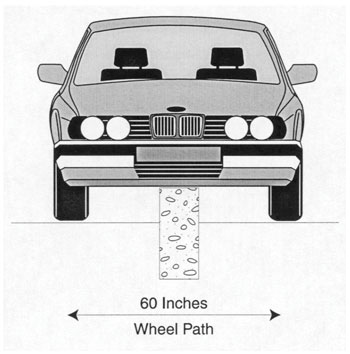
In flat areas, 1V:10H or milder, fixed objects such as headwalls, should not extend more than 4 inches above the surrounding ground. Fixed objects that are higher than 4 inches can catch or snag part of a small vehicle undercarriage causing abrupt stopping, loss of control, and/or vehicle overturning.
Headwalls that are hazardous are often easy to identify by scars left on them from previous crashes. Headwalls that have been hit should be replaced with a traversable end treatment or crashworthy safety feature rather than replaced or repaired in kind. As an immediate, temporary treatment, the headwall should be delineated with a retroreflective object marker consistent with the current edition of the Manual on Uniform Traffic Control Devices.

Improving Hazardous Pipe and Culvert Ends
Pipe and culvert ends vary widely. Many are just extensions of the pipe beyond an embankment. These ends are used because they are inexpensive and tend to limit the erosion around the sides of the pipe, or it may be that it was simpler to just leave the last section of pipe, rather than trying to dress it. Unfortunately, many pipe and culvert ends are within the area required by a driver to recover control or stop a vehicle that has left the travel way.
When pipe or culvert ends are within this recovery area or “clear zone,” it should be designed and maintained as a traversable feature of the roadside.
Several features of a pipe or culvert end can be hazardous to motorists, bicyclists or pedestrians that leave the travel way. These features include: (1) how well or poorly the pipe or culvert end conforms to the ground, (2) the size and shape of the end opening, and (3) the orientation and location of the pipe opening.
One of the best ways to ensure that the pipe or culvert end is not hazardous is to place the end substantially beyond the clear zone. Unfortunately, cost, geography, and/or right-of-way restrictions can be factors that limit the extension of pipe and culvert ends.
In areas where potential roadside hazards already exist, such as trees that are close to the travel way, pipe and culvert ends can be extended to beyond the tree line rather than in front of it. While this action does not reduce the existing hazardous nature of the roadside, it does not create additional hazards.
End sections within the clear zone of the roadside should be designed and maintained to be traversable features. First they should conform to the ground around them. An exposed end (pipe or culvert sections sticking up above the ground) can initiate vehicle instability and cause the driver to lose control. End sections more than 4 inches above the surrounding ground can snag the undercarriage of a vehicle, causing it to stop abruptly or to vault or roll over.
To minimize the potential of vehicle snagging on the end of a pipe, it is necessary to provide a traversable end section, ensuring that either the pipe end is cut flush with the ground line, or when used, that the steel grating is sloped flush with the surface.
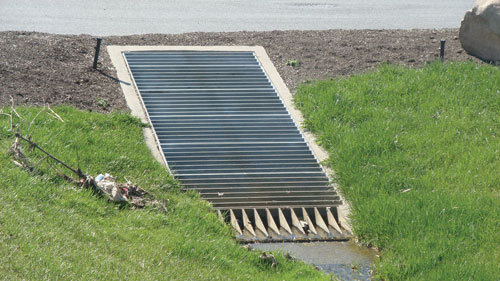
A second safety consideration, important to all large pipe and culvert ends located in the clear zone, is the size or width of the opening. Pipes and culverts can trap a vehicle wheel if the opening is too large, causing it to stop abruptly or initiate overturning. Generally, openings that are larger than 30 inches are considered potential hazards; however vehicles may safely traverse over openings up to 30 inches. In crash tests of vehicles at normal highway speeds it was demonstrated that vehicle tires could cross over openings of 30 inches provided that the opening has been cut to match a traversable side slope.
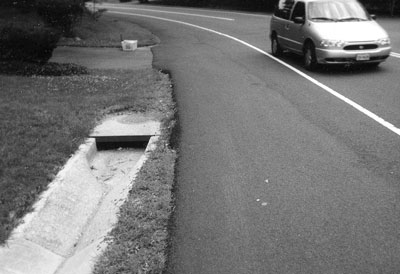
Large openings of pipe and culvert ends can often be made traversable for a vehicle by construction of an open pipe grate across the potential path of the vehicle. Pipe grates need to be of sufficient strength to accommodate a vehicle and should be removable or hinged to provide for maintenance. Design of the pipe grate is important to safety and varies with the size, shape, location, and orientation of the pipe.
A potential source of information on safety treatments for pipe and culvert openings is State standard drawings for highway drainage and the Roadside Design Guide. Another potential source of information are the offices of the Local Technical Assistance Program (LTAP).
Maintaining Good Drainage at Intersections and Access Points
Access points, such as road intersections, driveways, pedestrian and bicycle crossings are important areas where drainage features should be reviewed and, where appropriate, improvements made.
At access points the grade of the highway and the access point have to meet. Consequently, the free flow of run-off is restricted and some drainage feature is usually built to move the water away. Drainage facilities, particularly those for driveways, may have been poorly constructed by developers or property owners and may be potential hazards. Local jurisdictions may have established laws requiring access points to be free of hazards and obstacles that could affect the safety of the traveling public.
